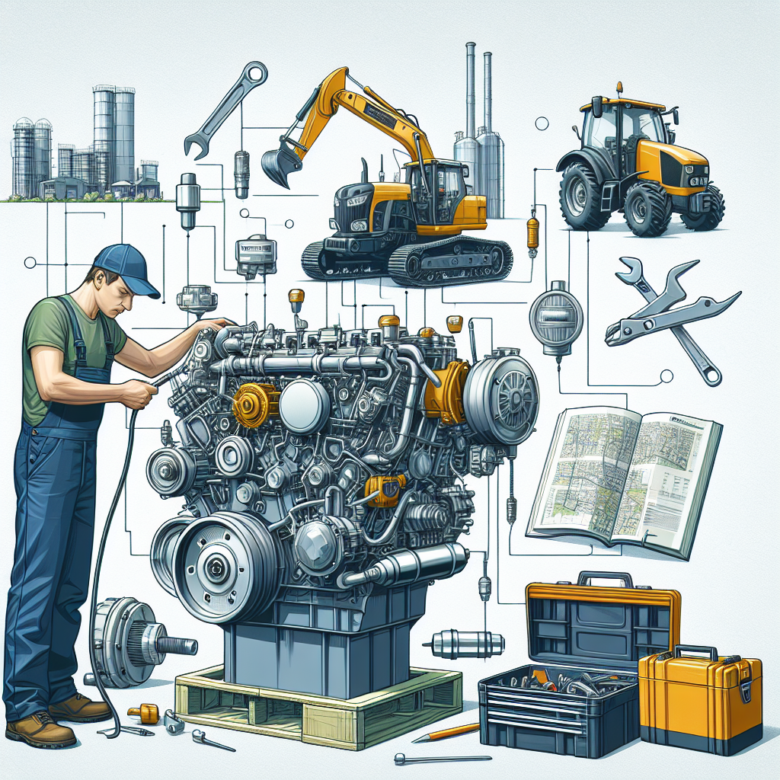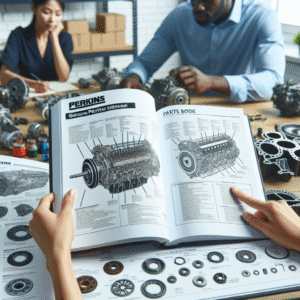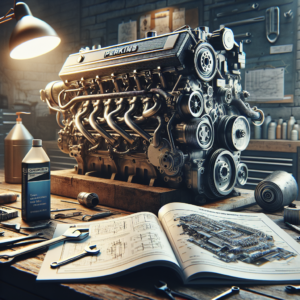Perkins engines are renowned for their reliability and efficiency in various industrial applications, from agriculture to construction. However, like any mechanical system, they require regular maintenance and occasional repair to ensure optimal performance. To achieve this, following the manufacturer’s guidance is crucial. This article delves into the importance of adhering to manufacturer guidelines when repairing and overhauling Perkins engines. Additionally, it outlines the key steps in the overhaul process, common issues and their solutions, and the essential tools and resources for effective maintenance.
Importance of Manufacturer Guidance in Perkins Engine Repair
When it comes to repairing Perkins engines, the manufacturer’s guidance is invaluable. These engines are complex machines with intricate systems that require precise handling. The manufacturer’s guidelines provide detailed instructions on the correct procedures, ensuring that repairs are performed accurately and efficiently. This not only extends the engine’s lifespan but also maintains its performance and reliability.
Adhering to manufacturer guidance helps prevent common mistakes that can occur during the repair process. For instance, using incorrect parts or improper techniques can lead to further damage and costly repairs. By following the specified guidelines, technicians can avoid these pitfalls and ensure that every component is handled correctly.
Moreover, the manufacturer’s guidance includes crucial safety information. Repairing engines involves working with heavy machinery and potentially hazardous materials. The guidelines provide safety protocols to protect technicians from injuries and accidents. This is particularly important in professional repair settings where multiple workers may be involved in the process.
The manufacturer’s guidance also ensures compliance with warranty requirements. Many Perkins engines come with warranties that stipulate specific maintenance and repair procedures. Failing to follow these guidelines can void the warranty, leaving the owner responsible for any resulting damages. By adhering to the manufacturer’s instructions, owners can safeguard their investment.
Additionally, using the manufacturer’s guidance supports the integrity of the engine. Perkins engines are designed with specific tolerances and specifications. Deviating from these can impact the engine’s performance and efficiency. Following the guidelines ensures that the engine operates as intended, providing optimal power and fuel efficiency.
Finally, the manufacturer’s guidance is continuously updated with the latest information and best practices. This ensures that technicians have access to the most current repair techniques and parts recommendations. By staying up-to-date with these guidelines, repair professionals can provide the best possible service to their clients.
Key Steps in Overhauling Perkins Engines Effectively
Overhauling a Perkins engine is a meticulous process that requires attention to detail and adherence to specific steps. The first step is to conduct a thorough inspection of the engine. This involves checking for signs of wear and tear, leaks, and any other issues that may affect performance. Detailed inspection helps in identifying the components that need replacement or repair.
Once the inspection is complete, the next step is to disassemble the engine. This should be done methodically, taking care to label and organize parts for easy reassembly. The manufacturer’s guidance provides detailed instructions on disassembly, ensuring that each component is handled correctly and safely.
Cleaning is a critical step in the overhaul process. All engine parts should be thoroughly cleaned to remove dirt, oil, and debris. This not only improves the performance of the engine but also helps in identifying any hidden damage. The manufacturer’s guidelines recommend specific cleaning agents and techniques that are safe for the engine components.
After cleaning, the next step is to inspect each part for damage or wear. Components such as pistons, bearings, and gaskets should be carefully examined. Any parts that are damaged or worn beyond acceptable limits should be replaced. The manufacturer’s guidance provides specifications for acceptable wear limits and recommended replacement parts.
Reassembling the engine is another crucial step that requires precision. Each part must be reinstalled in the correct order and to the specified torque settings. The manufacturer’s guidelines offer detailed reassembly instructions, ensuring that the engine is put back together correctly. This step is vital for the engine’s performance and longevity.
Finally, once the engine is reassembled, it should be tested to ensure it operates correctly. This involves running the engine and checking for any abnormalities in performance. The manufacturer’s guidance includes testing procedures and parameters, helping technicians verify that the overhaul has been successful and the engine is ready for use.
Common Issues and Solutions for Perkins Engines
Perkins engines, while reliable, can experience common issues that require attention. One common problem is overheating, which can be caused by a variety of factors such as coolant leaks, clogged radiators, or faulty thermostats. The manufacturer’s guidance provides troubleshooting steps to identify the root cause and recommended solutions, such as replacing the thermostat or flushing the radiator.
Another frequent issue is loss of power, which can stem from fuel system problems, air intake blockages, or worn-out components. Diagnosing the exact cause requires a systematic approach, following the manufacturer’s guidelines. Solutions may involve cleaning or replacing fuel filters, checking the air intake system, or servicing the turbocharger.
Oil leaks are also a common concern with Perkins engines. Leaks can occur due to worn seals, gaskets, or damaged oil pans. The manufacturer’s guidance offers detailed instructions on locating and fixing oil leaks. This may include replacing faulty seals or gaskets and ensuring that all components are properly torqued to prevent future leaks.
Starting difficulties can be another issue, often related to battery problems, faulty starters, or issues with the fuel system. The manufacturer’s troubleshooting steps help pinpoint the cause, whether it’s a weak battery, a defective starter motor, or clogged fuel injectors. Solutions typically involve testing and replacing the faulty components as needed.
Excessive smoke from the exhaust is a symptom that can indicate several underlying issues, such as poor fuel combustion, oil burning, or clogged air filters. The manufacturer’s guidance provides a step-by-step approach to diagnose and address the problem. This may involve adjusting the fuel injection system, replacing air filters, or checking for oil leaks into the combustion chamber.
Lastly, unusual noises from the engine, such as knocking or rattling, can signal problems with internal components like pistons or bearings. Following the manufacturer’s diagnostic procedures helps in identifying the exact cause of the noise. Solutions may include replacing damaged pistons or bearings and ensuring that all internal components are within the specified tolerances.
Tools and Resources for Perkins Engine Maintenance
Maintaining Perkins engines requires a variety of specialized tools and resources. One essential tool is the diagnostic scanner, which allows technicians to read error codes and monitor engine performance. The manufacturer’s guidance often includes recommendations for compatible diagnostic tools that provide accurate readings and facilitate efficient troubleshooting.
Another critical resource is the Perkins manual, which contains comprehensive information on maintenance procedures, part specifications, and troubleshooting steps. This manual is an invaluable reference for technicians, providing detailed instructions and diagrams that are crucial for proper maintenance and repair.
Torque wrenches are also essential tools for Perkins engine maintenance. These wrenches ensure that bolts and nuts are tightened to the manufacturer’s specified torque settings, preventing over-tightening or under-tightening, which can lead to component failure. The manufacturer’s guidance includes the correct torque values for various engine components.
Specialized cleaning tools are necessary for maintaining Perkins engines. These include brushes, solvents, and ultrasonic cleaners designed to remove dirt and debris from engine parts without causing damage. The manufacturer’s guidelines specify the appropriate cleaning agents and techniques to use for different components.
Another important resource is access to genuine Perkins parts. Using original parts ensures compatibility and reliability, as they are designed to meet the manufacturer’s specifications. The Perkins manual often includes part numbers and sourcing information, helping technicians obtain the correct components for repairs and maintenance.
Finally, training and certification programs offered by Perkins or authorized dealers are valuable resources for technicians. These programs provide hands-on training and detailed knowledge of Perkins engines, ensuring that technicians are well-equipped to handle maintenance and repairs. The manufacturer’s guidance often highlights the importance of ongoing training to stay updated with the latest techniques and technologies.
In conclusion, repairing and overhauling Perkins engines is a task that demands strict adherence to the manufacturer’s guidance. The detailed instructions and safety protocols provided by Perkins ensure that engines are repaired correctly, maintaining their reliability and efficiency. By following the outlined steps for overhauling, addressing common issues with informed solutions, and utilizing the right tools and resources, technicians can effectively maintain and repair Perkins engines. For comprehensive information on procedures and parts, the Perkins manual remains an indispensable resource, ensuring that every repair and maintenance task is performed to the highest standard.



